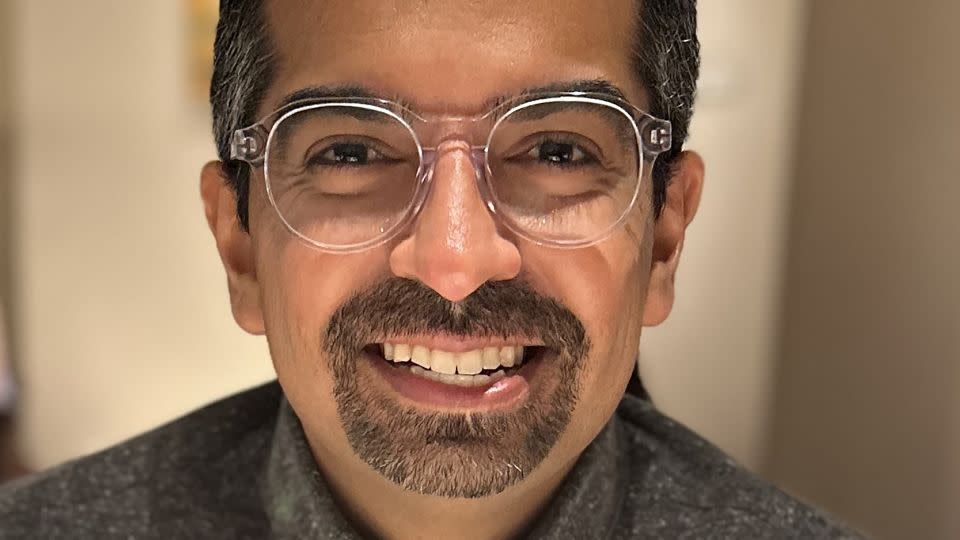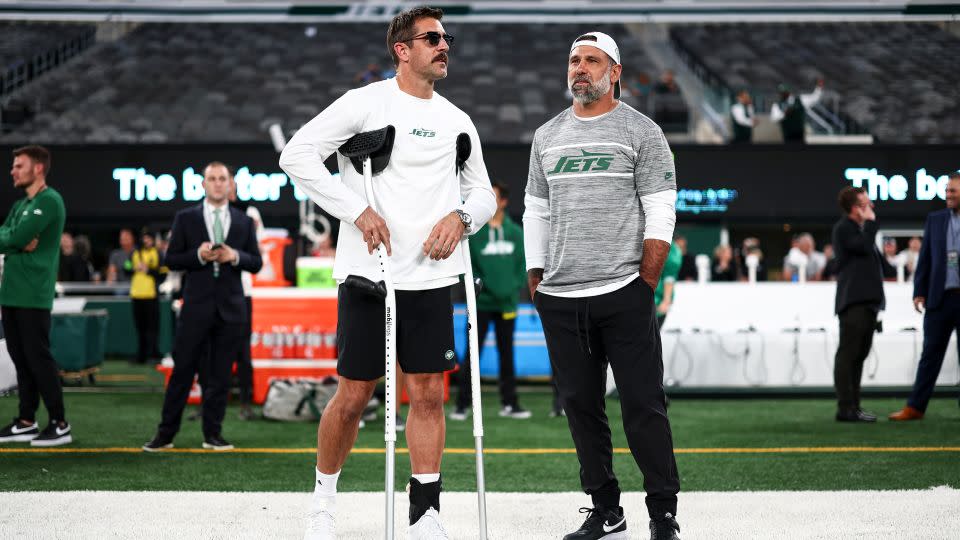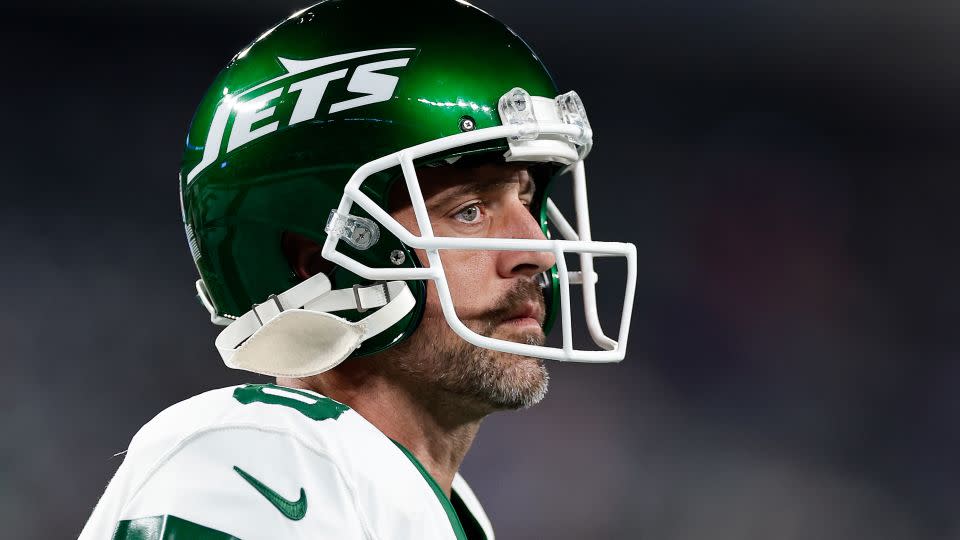Opinion: Why Aaron Rodgers’ speedy return to football would set a bad precedent

- Oops!Something went wrong.Please try again later.
- Oops!Something went wrong.Please try again later.
Editor’s Note: Jalal Baig is a physician and writer based in Chicago whose work has appeared in the Washington Post, NBC News, The Atlantic, Foreign Policy and other publications. The views expressed in this commentary are his own. Read more opinion at CNN.
It’s looking increasingly unlikely that Aaron Rodgers will return to the football field this year, according to news reports this week. And truth be told, that’s probably a good thing.

Last week, the marquee NFL quarterback announced that he was considering a return to the gridiron this season, less than three months after suffering a devastating Achilles tendon rupture minutes into his debut with the New York Jets.
Rodgers is a future Hall of Fame player with access to state-of-the-art medical care and cutting-edge rehab protocols. He is also known to possess a stubborn competitive spirit and a drive to try to achieve on the football field what seems unachievable. It’s no surprise that he would want to attempt an unprecedented recovery after [his] Achilles surgery.
“Anything is possible,” said Rodgers in a recent interview when asked about the prospects of a return to playing this year. “It’s not ‘why try?’, it’s ‘why not?’” he said.
“From September 12 on, my goal was to come back to the practice field and try to play. It was contingent on my health and our team being in position to make a run. That’s why I worked so hard for those 77 days, to get back on the field,” he added.

But reason appears to have won out. In the face of the Jets’ waning playoff fortunes, the four-time NFL MVP appears to have halted his pursuit to return this year in favor of an optimal return for next season.
For medical professionals like myself, there were always serious doubts as to whether Rodgers would be able to overcome the natural limits of human biology and recover from his injury on an accelerated timeline.
The quandary faced by Rodgers is one that many professional athletes confront at some point in their careers when hurt. For them, there will be pressures to return after a major injury that the average patient will never be subjected to.
Rodgers came to the Jets earlier this year after a storied career with the Green Bay Packers, where he was considered key to the team’s ability to contend for the postseason.
But just four plays into the new season, the quarterback was injured during a sack by Buffalo Bills defensive end Leonard Floyd. Two days later, Rodgers underwent an Achilles’ repair surgery by orthopedic surgeon Dr. Neal ElAttrache, who has operated on numerous elite athletes. From the beginning, Rodgers says he was asking his doctor about how fast they could speed his recovery.
“I asked [Dr. ElAttrache] if we could push it, if we could push it beyond the normal protocols. I’ve just wanted to do things quicker, smart, but quicker. It’s just about being smart with the rehab and pushing it as much as I can and then backing off on the days that it doesn’t feel good,” Rodgers said, according to an article published on the Jets’ website.
The part of the body that Dr. ElAttrache was tasked to operate on is crucial for a football player’s success. A 2023 study found that more than 40% of NFL skilled position players do not successfully return to play after rupturing their Achilles tendon.

The Achilles tendon is a band of connective tissue that links calf muscles to the heel. It is the body’s largest tendon and makes an athlete’s explosiveness and essential movements possible.
In order to potentially expedite Rodgers’ recovery, an internal brace — called a SpeedBridge technique — was used to connect the top part of the Achilles tear to the heel bone. The brace consists of a very strong and wide suture tape that spans and mechanically protects the rupture site.
“Before this device was around, you really couldn’t rehab [athletes] incredibly fast because as you rehab, you are putting stress on the repair site. Now, because you are protecting the repair site with the suture, you can actually rehab them sooner,” Dr. Selene Parekh, a professor of orthopedic surgery at Thomas Jefferson University told me, adding that the device can allow an athlete to get “back in the game a little bit quicker.”
One of the first prominent athletes to use the SpeedBridge protocol was running back Cam Akers, who tore his right Achilles tendon prior to the 2021 NFL season. He returned to the Los Angeles Rams less than six months later and in time for the playoffs. While his overall playoff performances were middling with 67 carries for 172 yards, his comeback was achieved far sooner than the usual nine- to 12-month timetable.
But some experts in the field of orthopedics say the SpeedBridge should not be considered a panacea that can circumvent human physiology. The Achilles tendon needs at least five to six months to heal, they say, before it can be safely exposed again to the demands of professional football.
“In orthopedics, we haven’t necessarily found amazing ways to cheat Mother Nature as we like to sometimes think. At the end of the day, there’s no question he [Rodgers] is not as healed now as he would be half a year from now,” Dr. Daniel Guss, a professor of orthopedic surgery at Harvard Medical School, told me.
“Athletes have superhuman abilities, but not superhuman biology,” Guss said.
A traditional, pocket-passing quarterback like Rodgers may face fewer risks from surgery than a wide receiver or running back, whose style of play requires sharp changes of direction and explosive bursts of speed. But an unhealed tendon always remains vulnerable to catastrophic re-rupturing or to becoming stressed and re-injured.
Apart from these complications, his well-publicized possible return risks setting dangerous precedents for similarly stricken athletes in the future.
If Rodgers can return to quarterback the Jets in less than three months after a grievous injury, other NFL and college and high school players will envision similar recoveries for themselves. And inevitably, these expectations will ripple outside football to other sports.
Of course, there’s no uniform timetable given the manifold considerations — age, position, contractual status, available medical resources, personal aims — surrounding each individual’s comeback from injury.
This is where doctors will have to emphasize to their patients, also eager to speed up the timeline of return from injury, the limited applicability of his story, tantalizing though it may be. The application of advancements in sports medicine must always be tailored to each individual patient’s best interest.
What is clear is that Rodgers’ injury has had a seismic effect on the floundering Jets’ franchise, which remains deeply unsettled at the quarterback position as their season limps to a close.
Die-hard fans may still be clamoring for a Rodgers return to salvage their season, but most of us are glad that it looks like he’ll be taking time to heal. That’s good news for his career going into next year, as well as for the fortunes of his team.
For more CNN news and newsletters create an account at CNN.com

